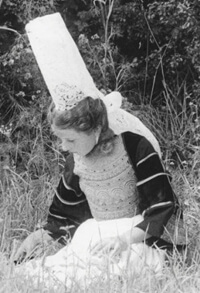I love playing history detective. It always takes you to places you could not expect!
This time it starts with the story of an ordinary pair of painted Brittany wooden shoes seen at the Vermont Antique Show last week, and ends with Paul Gauguin’s carved wooden shoes which sold this week for nothing less than $340,000 at a Sotheby’s auction!
Last week, at the Vermont Antique Show, an exhibitor had a pair of old wooden shoes, each shoe painted with the face of a Brittany woman wearing the traditional intricate lace head-dress, called “coiffe”.
The words “Bretagne”, “Pont-Aven” and “bigouden” were also painted on the shoes. Of course, it caught my attention!
These shoes were obviously from my home region Brittany. They were old but obviously made for tourists. “Bretagne” means Brittany, Pont-Aven is a little village in the South of Brittany, and “bigouden” is the region where Pont-Aven is located and can also refer to the style of the head-dress from that region.
So I asked the antique shop owner if she knew where these shoes were from. “Germany?” she said. “No” I replied. “Holland?“. “No” I replied again. I have to say I was very surprised that an antique shop owner was so non-inquisitive.
How easy was it to search the word “Bretagne” to realize these were from Brittany? Isn’t it what antiques are all about?
It definitely leads me to believe that we can still find some treasures out there if even an antique shop owner knows so little about the antiques she sells!
Well, interestingly, Pont-Aven is also very famous for the “École de Pont-Aven”, a group of artists led by Paul Gauguin who worked and lived there from the late 19th century to the early 20th century. Paul Gauguin loved the way of life in Brittany.
That is how he described it in a letter to his friend Emile Schuffenecker: “I love Brittany which I find savage and primitive. When my clogs ring on the granite ground I hear the dull and powerful sound that I am looking for in painting” (Victor Merles, ed., Correspondence de Paul Gauguin, Paris, 1984, letter 141, p. 172).
And Paul Gauguin actually made at least 3 pairs of those traditional wooden shoes (“sabots”) Brittany people wore. The pair shown above is at the National Gallery of Art (see Paul Gauguin’s wooden shoes), one is in a private collection in Paris, and the 3rd one (unbelievable) was sold last week at a Sotheby’s auction for a record price of $338,500 as reported by the Telegraph in this article! A fascinating story indeed.




Hello Christine I just came across your site looking for history on wooden shoes in France. So happy to find out the connection to Brittany. I have a tiny pair of handcarved wooden shoes i bought at an estate sale years back in Lansing, MI The shoes are orange and on the top in white is a banner “France” in red and a double white cross. I have always wanted to visit France and will make my first trip in July to stay with my daughter, son-in-law and 2 small granddaughters in Mouries who will be there for 2 months from CA.
Thank you for your wonderful Blog. Toni
Well the two-barred cross is the Cross of Lorraine. In France, it is the symbol of the Free French Forces of World War II, the liberation of France from Nazi Germany, and Gaullism and several variations exist. So your little wooden shoes can actually come from another part in France than Brittany!
Thank you again. You have been most helpful. Toni
My Grandfather brought me a pair of hand carved wooden shoes with the accompanying woollen slippers, from Bretagne 64 years ago. I was 5 at the time and they were in my size. They are still beautiful, in perfect shape, with the upper shoes having carvings of the heads of the Breton man an woman. My Father was born in Chateaulin, my Grandmother in Pleyben and my Grandfather in Goezic. I went to Bretagne this past year, looking to find the wooden shoes and hand made Breton wooden boxes, that my Grandmother used to bring back for me. Unfortunately I never saw them, sadly, it must be a dying or lost craft.
My ancestors from the St Brieuc region, St Carreuc, were sabotiers. In the Poitou region, where my maternal ancestors originated were farmers, but they always used the sabot with a felt or leather slipper which we called sabarins. Apparently, the french language didn’t recognize the word. Perhaps, it was of Poitou origine only. Many words in the Poitevin language are issued from english, or some german. Never saw sabots in the US. Guess the farmers never wore them, nor the Amish in Pennsylvania where we used yo live. They surely don’t in Iowa.